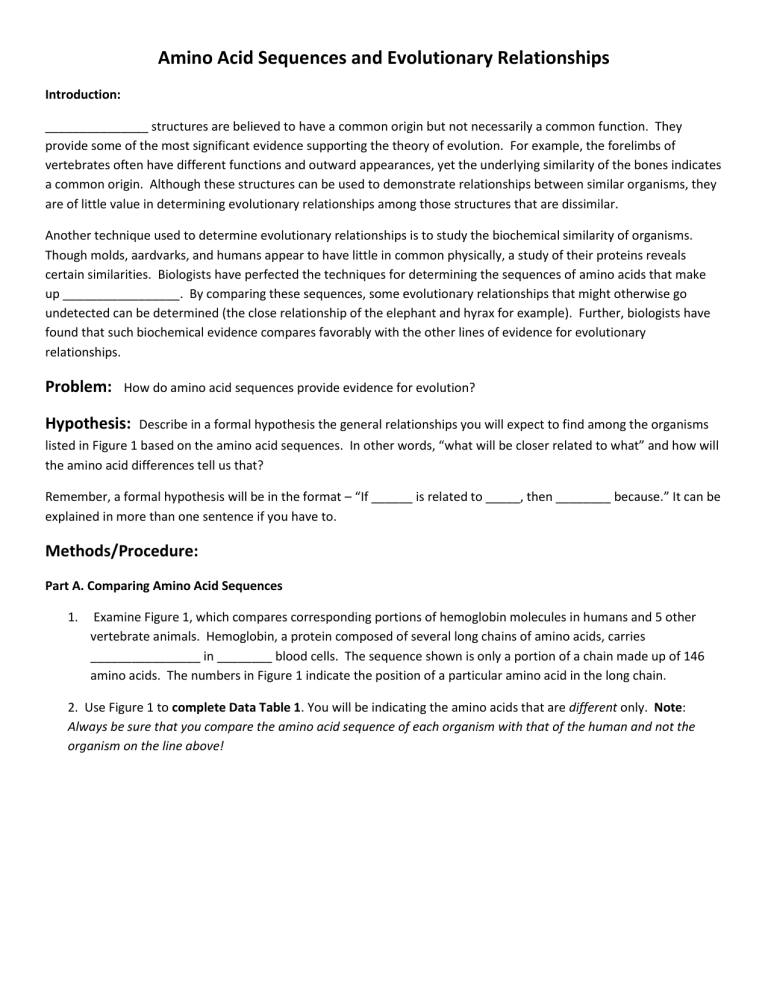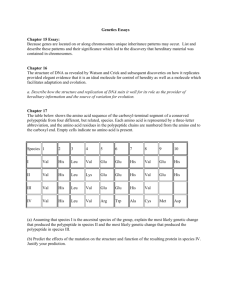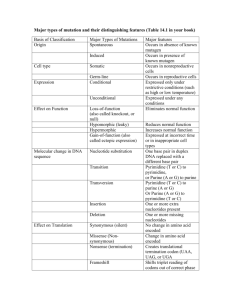Amino-acid-evolutionary-relationships-Lab-29zv5w5
advertisement

Amino Acid Sequences and Evolutionary Relationships Introduction: _______________ structures are believed to have a common origin but not necessarily a common function. They provide some of the most significant evidence supporting the theory of evolution. For example, the forelimbs of vertebrates often have different functions and outward appearances, yet the underlying similarity of the bones indicates a common origin. Although these structures can be used to demonstrate relationships between similar organisms, they are of little value in determining evolutionary relationships among those structures that are dissimilar. Another technique used to determine evolutionary relationships is to study the biochemical similarity of organisms. Though molds, aardvarks, and humans appear to have little in common physically, a study of their proteins reveals certain similarities. Biologists have perfected the techniques for determining the sequences of amino acids that make up _________________. By comparing these sequences, some evolutionary relationships that might otherwise go undetected can be determined (the close relationship of the elephant and hyrax for example). Further, biologists have found that such biochemical evidence compares favorably with the other lines of evidence for evolutionary relationships. Problem: How do amino acid sequences provide evidence for evolution? Hypothesis: Describe in a formal hypothesis the general relationships you will expect to find among the organisms listed in Figure 1 based on the amino acid sequences. In other words, “what will be closer related to what” and how will the amino acid differences tell us that? Remember, a formal hypothesis will be in the format – “If ______ is related to _____, then ________ because.” It can be explained in more than one sentence if you have to. Methods/Procedure: Part A. Comparing Amino Acid Sequences 1. Examine Figure 1, which compares corresponding portions of hemoglobin molecules in humans and 5 other vertebrate animals. Hemoglobin, a protein composed of several long chains of amino acids, carries ________________ in ________ blood cells. The sequence shown is only a portion of a chain made up of 146 amino acids. The numbers in Figure 1 indicate the position of a particular amino acid in the long chain. 2. Use Figure 1 to complete Data Table 1. You will be indicating the amino acids that are different only. Note: Always be sure that you compare the amino acid sequence of each organism with that of the human and not the organism on the line above! Figure 1 87 THR THR THR Human chimpanzee Gorilla Rhesus GLN monkey Horse ALA Kangaroo LYS 102 Human ASN chimpanzee ASN Gorilla ASN Rhesus ASN monkey Horse ASN Kangaroo ASN 88 LEU LEU LEU 89 SER SER SER 90 GLU GLU GLU 91 LEU LEU LEU 92 HIS HIS HIS 93 CYS CYS CYS 94 ASP ASP ASP 95 LYS LYS LYS 96 LEU LEU LEU 97 HIS HIS HIS 98 VAL VAL VAL 99 ASP ASP ASP 100 PRO PRO PRO 101 GLU GLU GLU LEU SER GLU LEU HIS CYS ASP LYS LEU HIS VAL ASP PRO GLU LEU LEU SER SER GLU GLU LEU LEU HIS HIS CYS CYS ASP ASP LYS LYS LEU LEU HIS HIS VAL VAL ASP ASP PRO PRO GLU GLU 103 PHE PHE PHE 104 ARG ARG LYS 105 LEU LEU LEU 106 LEU LEU LEU 107 GLY GLY GLY 108 ASN ASN ASN 109 VAL VAL VAL 110 LEU LEU LEU 111 VAL VAL VAL 112 CYS CYS CYS 113 VAL VAL VAL 114 LEU LEU LEU 115 ALA ALA ALA 116 HIS HIS HIS PHE LYS LEU LEU GLY ASN VAL LEU VAL CYS VAL LEU ALA HIS PHE PHE ARG LYS LEU LEU LEU LEU GLY GLY ASN ASN VAL ILE LEU ILE ALA VAL LEU ILE VAL CYS VAL LEU ALA ALA ARG GLU *Human hemoglobin is being used as the standard for comparison. Data/Results Data Table 1 – give it a title and put into your notebook. Organisms Human & Chimpanzee Human & Gorilla Human & Rhesus Monkey Human & Horse Human & Kangaroo Number of Amino Acid Differences Positions in which They Vary Part B. Inferring Evolutionary Relationships from Differences in amino Acid Sequences 1. Another commonly studied protein is cytochrome c. This protein, consisting of 104 amino acids, is located in the mitochondria of cells. There it functions as a respiratory enzyme. Examine figure 2. Using human cytochrome c as a standard, the amino acid differences between humans and a number of other organisms are shown. Figure 2 Species Pairings Human - chimpanzee Human - fruit fly Human - horse Human - pigeon Human - rattlesnake Human - red bread mold Human - rhesus monkey Human - screwworm Human - snapping turtle Human - tuna Human - wheat 2. Number of Differences 0 29 12 12 14 48 1 27 15 21 43 Using Figure 2, construct a bar graph in your notebooks to show the amino acid differences between humans and other organisms. Be sure that your graph is properly labeled and easy to read. Spend some time organizing it before you start. 3. Now examine Figure 3. In this figure the cytochrome c of a fruit fly is used as the standard in comparing amino acid differences among several organisms. Which animal is the fruit fly’s closest relative? _________________ Construct a pie chart to show these differences. Figure 3 Species Pairings Number of Differences Fruit fly-dogfish shark Fruit fly-pigeon Fruit fly-screwworm fly Fruit fly-silkworm moth 26 25 2 15 Fruit fly-tobacco hornworm moth Fruit fly-wheat 14 47 Analysis of Results – write a 1 paragraph summary of what the data tables and graphs show. Discussion – put the answers in compete sentences in your notebooks 1. According to Figure 1 and the bar graph, which organism appears to be the least closely related to humans? Explain why. (Include a comparison of the type of animal it is.) 2. According to cytochrome c differences, which 2 organisms are the most similar to humans? 3. What are some physical characteristics that we have in common with those 2 organisms? 4. Which 2 are the least similar to humans? 5. There is a difference of only one amino acid in one chain of the hemoglobin of humans and gorillas. What might have caused this difference? 6. If the amino acid sequences in the proteins of 2 organisms are similar, why will their DNA also be similar? 7. Many biologists believe that the number of differences between the proteins of different species indicates how long ago the species diverged from common ancestors. Why do these biologists believe that humans, chimpanzees, and gorillas diverged from a common ancestor only a few million years ago? 8. Species X and Y have 25 amino acid differences. Species X and B have 10 amino acid differences in the same protein. Species Y and B have 27 amino acid differences. A phylogenetic tree/cladogram would look like this: Y X B Y and B diverged first because they have the most differences. X and B diverged more recently because they have fewer differences. ---Construct a phylogenetic tree based on the species and information in Figure 2.




